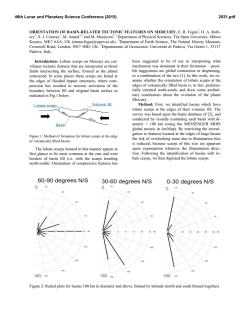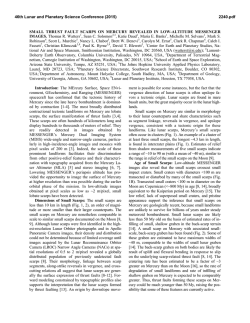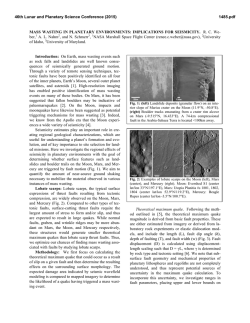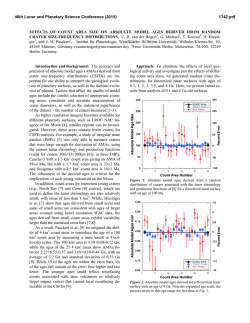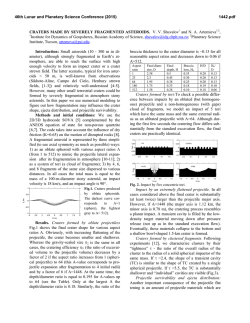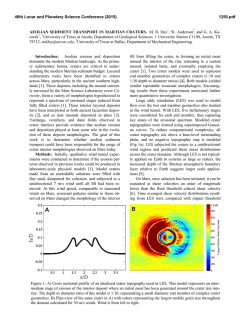
HOW YOUNG ARE LUNAR LOBATE SCARPS? J. D. Clark1, C. H.
46th Lunar and Planetary Science Conference (2015) 1730.pdf HOW YOUNG ARE LUNAR LOBATE SCARPS? J. D. Clark1, C. H. van der Bogert1, and H. Hiesinger1, 1 Institut für Planetologie, Westfälische Wihelms-Universität, Wilhelm-Klemm-Str. 10, 48149 Münster, Germany ([email protected]). Introduction: Interior cooling and contraction of the Moon, resulted in compressional features called lobate scarps, the surface expression of low angle thrust faults [1-3]. Based on their generally crisp appearance and the absence of superimposed, largediameter impact craters (>400m), lobate scarps are among the youngest landforms on the Moon (< 1 Ga) [4-6]. Binder and Gunga [7] used crater degradation measurements on craters transected by or superposed on the scarps to derive ages for 20 lobate scarps. The majority of derived model ages indicated relatively concise scarp ages, implying a short formation period, while a few others exhibited multiple episodes of deformation [7]. Copernican in age, the scarp age estimates ranged from 60±30 Ma to 680±250Ma [7]. These early investigations of lobate scarps were conducted using images from the Apollo Panoramic Camera limited to the equatorial region [7]. Today, we have the opportunity to look at additional lobate scarps at high resolution using images obtained by the Lunar Reconnaissance Orbiter Camera (LROC) [5]. LROC has revealed a true global distribution with over 2,700 lobate scarps identified thus far [8]. Moreover, the method of crater size-frequency distriution (CSFD) measurements was developed by [9,10] before the work of [7]. Conventionally, CSFD measurements are used to derive ages for well-defined geologic units, such as impact deposits and basalt flows. However, [11] adapted the technique for use on lobate scarps, based on the discovery that shaking during scarp formation seems to have caused local resurfacing of small craters. Here, we further apply the technique on 20 additional lobate scarps, to investigate the range of scarp ages. Overall, investigating the age of the lobate thrust fault scarps will provide new insights into the late-stage tectonic evolution of the Moon. Data and Methods: We used NAC (Narrow Angle Camera) image data, which were processed using Integrated Software for Imagers and Spectrometers (ISIS) [12] and imported into ArcGIS. Count areas and crater measurements were generated using CraterTools [13]. The CSFDs were plotted and fit with CraterStats [14], using techniques as described in [9]. The derived absolute model ages (AMAs) are based on the chronology function (CF) and production function (PF) of [10], valid for lunar craters >10 m and <100 km in diameter. For this study, we used the same method as described in [11] and illustrated in Fig. 1, where we derived AMAs for proximal and distal areas of the thrust fault hanging walls and footwalls. Previous AMAs derived by [11] showed that the hanging wall of the lobate scarp generally displays a younger AMA than the footwall. This difference in age was interpreted to be caused by differences in shaking during scarp formation [11]. Results: Our absolute model ages from CSFD measurements indicate that lobate scarp ages range from 60 to <600 Ma, implying geologically recent faulting. This is consistent with the work of [5,7,11,15]. Although some locations exhibited multiple resurfacing events, proximal hanging walls tend to be younger than the footwalls as observed by [11] and Figure 1. Locations of count areas at Barrow scarp (69.9N, 4.80E) showing CSFD measurement technique of [11] on NAC image pair M1116516111. 46th Lunar and Planetary Science Conference (2015) Figure 2. CSFDs measured at Barrow scarp for the hanging wall (red) and footwall (blue). seen in Fig. 2. In Fig. 3, the CSFDs obtained during the present study are plotted versus their respective fault surfaces. All scarp proximal hanging walls are younger than their proximal footwalls. At distal locations, the foot- Figure 3. AMAs versus locations perpendicular to the footwall (FW) and hanging wall (HW) of the fault, where the fault lies between FW2 and HW2. 1730.pdf wall tends to be younger than its proximal counterpart, while the hanging walls increase in age. We interpret those distal hanging walls in Fig. 3 with ages > 600Ma as approaching the background surface age. Differences in fault geometry likely influences the heterogeneity in surface ages both proximal and distal from the fault. Comparing our AMAs to those of [7], on average our ages are slightly younger by 10s of Ma. Both our crater counting approach and the high-resolution NAC images may allow craters to be measured with greater accuracy and for smaller scarps, thus allowing us to derive younger AMAs. Summary and Outlook: AMAs derived to date, along with the crisp appearance of lobate scarps, imply geologically recent faulting, consistent with the work of [5,11,15]. Such results have implications for the thermal history models for either an initially totally molten Moon or an early Moon with a magma ocean. Additional scarps are being investigated, and the results will be incorporated into Fig. 3 allowing a greater ability to interpret the timing of faulting events. Also, CSFD measurements will be done on Wide Angle Camera (WAC) images of the areas surrounding lobate scarp to gather a background surface age for comparison with local faulting and other geological activity. This ongoing investigation will also incorporate additional model age determination techniques to compare the counting approaches and the resulting AMAs. One of these methods includes the buffered crater counting technique where craters are mapped that superpose the linear feature and an effective counting buffer area is used to acquire more accurate CSFDs [13,16]. References: [1] Hartmann W.K. and Davis D. (1975) Icarus, 24, 504-515. [2] Cameron A.G.W. and Ward W.A. (1976) Lunar Science VII, 120-122. [3] Binder A.B. (1982) Moon and Planets, 26, 117-133. [4] Schultz (1976) Moon Morphology, Austin, TX. [5] Watters T.R. et al. (2010) Science, 329, 936-940. [6] Binder A.B. (1986) Papers Presented to the Conference on the Origin of the Moon, 425-433. [7] Binder A.B. and Gunga H. (1986) Icarus, 63, 421. [8] Watters T.R. et al. (2014) LPSC XLV, Abstract #2163. [9] Neukum (1983) Meteoritenbombardement und Datierung planetarer Oberflächen, Habil. Thesis, Univ. Munich. [10] Neukum et al. (2001) Space Sci. Rev., 96, 55. [11] van der Bogert C.H. et al. (2012) LPSC XLIII, Abstract #1847. [12] Anderson, J.A., et al., (2004) LPSC 35, #2039. [13] Kneissel et al. (2011) PSS, 59, 1243-1254. [14] Michael and Neukum (2010) EPSL, 294, 223. [15] Clark J.D. et al. (2014) LPSC XLV, Abstract #2048. [16] Kneissl T et al. (2014) Icarus, doi:10.1016/j.icarus.2014.12.008.
© Copyright 2025
